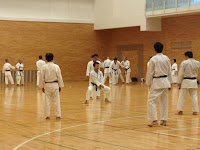On Sunday, December 20, the 2015 Gojuryu Karatedo Yoyogi Ryushinkan Black Belt Grading Examinations were held. The venue this year was the Shibuya Sports Center in Hatagaya, Tokyo. Aragaki Kancho supervised the grading session, assisted by other instructors from Ryushinkan.
Takahashi-san and Yumoto-san (both pictured left, with Aragaki Kancho) passed the rigorous session and have fully earned their black belts. Congratulations!


















.JPG)
.JPG)





